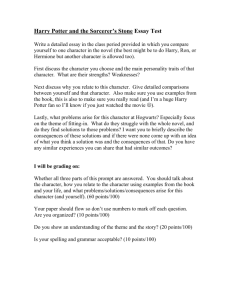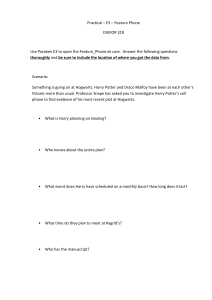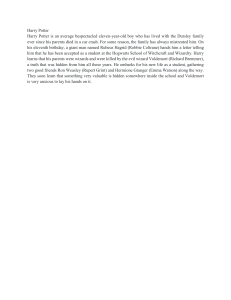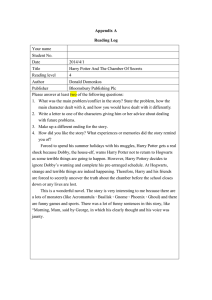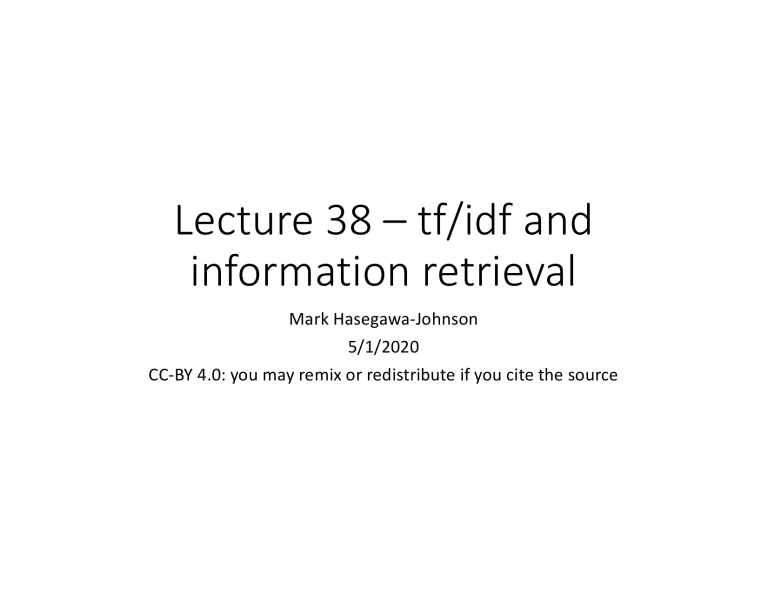
Lecture 38 – tf/idf and information retrieval Mark Hasegawa-Johnson 5/1/2020 CC-BY 4.0: you may remix or redistribute if you cite the source Outline • similarity vs. semantic field: word2vec at different scales • term frequency (tf): the term-document matrix • cosine similarity • document classification: tf on a log scale • document classification: inverse document frequency (idf) • relatedness again: the word co-occurrence matrix Similarity: The Internet is the database Similarity = words can be used interchangeably in most contexts How do we measure that in practice? Answer: extract examples of word 𝑤! , +/- k words (2 ≤ 𝑘 ≤ 5, for example): …hot, although iced coffee is a popular… …indicate that moderate coffee consumption is benign… …and of 𝑤" : …consumed as iced tea. Sweet tea is… …national average of tea consumption in Ireland… The words “iced” and “consumption” appear in both contexts, so we can conclude that 𝑠(coffea, tea) > 0. No other words are shared, so we can conclude 𝑠(coffee, tea) < 1. Similarity vs. Relatedness Levy & Goldberg (2014) trained word2vec in three different ways: • k=2 • k=5 • Context determined by first parsing the sentence to get syntactic dependency structure (Deps) They tested all three method for the similarity vs. relatedness of the nearest-neighbor of each word. Precision vs. Recall on the WordSim-353 database, in which word pairs may be either related or similar (Fig. 2(a), Levy & Goldberg 2014) Precision vs. Recall on the Chiarello et al. database, in which word pairs are only similar (Fig. 2(b), Levy & Goldberg 2014) Similarity vs. Relatedness • Apparently, the smaller context window (k=2) produces vectors whose nearest neighbors are more similar (they can be used identically in a sentence). • The larger context (k=5) produces vectors whose nearest neighbors are related, not just similar. • More specifically, the latter words pairs are said to inhabit the same semantic field. • A semantic field is a group of words that refers to the same subject. Precision vs. Recall on the WordSim-353 database, in which word pairs may be either related or similar (Fig. 2(a), Levy & Goldberg 2014) Precision vs. Recall on the Chiarello et al. database, in which word pairs are only similar (Fig. 2(b), Levy & Goldberg 2014) Similarity vs. Relatedness …studied at hogwarts, a castle… w=hogwarts … harry potter studied at hogwarts… vector nearest neighbors, context k=2 vector nearest neighbors, context k=5 …studied at evernight, a castle… evernight dumbledore …harry potter learned from dumbledore… …studied at sunnydale… sunnydale hallows …harry potter and the deathly hallows.. …a castle garderobe… garderobe blandings collinwood half-blood malfoy snape …harry potter and the half-blood… …lives at blandings, a castle… …lives at collinwood, a castle… Examples of k=2 and k=5 nearest-neighbors, from (Levy & Goldberg, 2014) …harry potter said to malfoy… …harry potter said to snape… What if you wanted semantic field, not similarity? w=hogwarts vector nearest neighbors, context k=2 vector nearest neighbors, context k=5 evernight sunnydale garderobe blandings collinwood dumbledore hallows half-blood malfoy snape • What if you wanted your vector embedding to capture semantic field, as in the second column (not similar usage, like the first column)? • If you want that, it seems that larger contexts are better. • Why not just set context window = the whole document? Outline • similarity vs. semantic field: word2vec at different scales • term frequency (tf): the term-document matrix • cosine similarity • document classification: tf on a log scale • document classification: inverse document frequency (idf) • relatedness again: the word co-occurrence matrix the term-document matrix document Hogwarts School of Witchcraft and Wizardry, commonly shortened to Hogwarts, is a fictional British school of magic for students aged eleven to eighteen, and is the primary setting for the first six books in J. K. Rowling's Harry Potter series… Albus Percival Wulfric Brian Dumbledore is a fictional character in J. K. Rowling's Harry Potter series. For most of the series, he is the headmaster of the wizarding school Hogwarts. As part of his backstory, it is revealed that he is the founder and leader of … Collinwood Mansion is a fictional house featured in the Gothic horror soap opera Dark Shadows (1966– 1971). Built in 1795 by Joshua Collins, Collinwood has been home to the Collins family—and other sometimes unwelcome supernatural visitors… term Hogwarts Dumbledore Collinwood a 1 1 1 of 1 2 in 1 1 2 is 2 4 1 fictional 1 1 1 school 1 rowling’s 1 1 harry 1 1 potter 1 1 series 1 1 house 1 featured 1 gothic 1 the term-document matrix From the term-document matrix, we can define each term vector to be just the vector of term frequencies: 𝑣(𝑖) ⃗ = [𝑡𝑓(𝑖, 1), … , 𝑡𝑓(𝑖, 𝐷)] …where we now define the term frequency (of term 𝑖 in document 𝑗) to be the number of times the term occurs in the document: 𝑡𝑓(𝑖, 𝑗) = Count word 𝑖 in document 𝑗 For example, 𝑣⃗ a = 1,1,1 𝑣(of) ⃗ = [1,2,1] 𝑣(potter) ⃗ = [1,1,0] document term Hogwarts Dumbledore Collinwood a 1 1 1 of 1 2 in 1 1 2 is 2 4 1 fictional 1 1 1 school 1 rowling’s 1 1 harry 1 1 potter 1 1 series 1 1 house 1 featured 1 gothic 1 Outline • similarity vs. semantic field: word2vec at different scales • term frequency (tf): the term-document matrix • cosine similarity • document classification: tf on a log scale • document classification: inverse document frequency (idf) • relatedness again: the word co-occurrence matrix cosine similarity The relatedness of two words can now be measured using their cosine similarity. For example, 𝑠(rowling ! s, harry) = cos ∡ rowling ! s, harry ! s) 5 𝑣(harry) 𝑣(rowling ⃗ ⃗ = ! s) 𝑣(harry) 𝑣(rowling ⃗ ⃗ = 1×1 + 1×1 + 0×0 2× 2 =1 𝑠(harry, gothic) = cos ∡ harry, gothic 𝑣(harry) ⃗ 5 𝑣(gothic) ⃗ = 𝑣(harry) ⃗ 𝑣(gothic) ⃗ = 1×0 + 1×0 + 0×1 2×1 =0 document term Hogwarts Dumbledore Collinwood a 1 1 1 of 1 2 in 1 1 2 is 2 4 1 fictional 1 1 1 school 1 rowling’s 1 1 harry 1 1 potter 1 1 series 1 1 house 1 featured 1 gothic 1 document vectors Now let’s try something different. Let’s define a vector for each document, rather than for each term: ⃗ 𝑑(𝑗) = [𝑡𝑓(1, 𝑗), … , 𝑡𝑓(𝑉, 𝑗)] Thus, 𝑑⃗ H = 1,1,1,2,1,1,1,1,1,0,0,0 ⃗ 𝑑(D) = [1,2,1,4,1,0,1,1,1,1,0,0,0] ⃗ 𝑑(C) = [1,0,2,1,1,0,0,0,0,0,1,1,1] document term Hogwarts Dumbledore Collinwood a 1 1 1 of 1 2 in 1 1 2 is 2 4 1 fictional 1 1 1 school 1 rowling’s 1 1 harry 1 1 potter 1 1 series 1 1 house 1 featured 1 gothic 1 information retrieval Document vectors are useful because they allow us to retrieve a document, based on the degree to which it matches a query. For example, the query: “What school did Harry Potter attend?” …can be written as a query vector: 𝑞⃗ = [0,0,0,0,0,1,0,1,1,0,0,0,0] We can sometimes find the most relevant document using cosine distance: 𝑞⃗ 5 𝑑⃗ H 3 = = 0.48 3 13 𝑞⃗ 𝑑⃗ H 𝑞⃗ 5 𝑑⃗ D 2 = = 0.22 ⃗ 3 27 𝑞⃗ 𝑑 D 𝑞⃗ 5 𝑑⃗ C 0 = = 0.00 ⃗ 3 10 𝑞⃗ 𝑑 C document term Hogwarts Dumbledore Collinwood a 1 1 1 of 1 2 in 1 1 2 is 2 4 1 fictional 1 1 1 school 1 rowling’s 1 1 harry 1 1 potter 1 1 series 1 1 house 1 featured 1 gothic 1 Outline • similarity vs. semantic field: word2vec at different scales • term frequency (tf): the term-document matrix • cosine similarity • document classification: tf on a log scale • document classification: inverse document frequency (idf) • relatedness again: the word co-occurrence matrix document classification Suppose that we find a new document on the web: Dark Shadows is an American Gothic soap opera that originally aired weekdays on the ABC television network, from June 27, 1966, to April 2, 1971. The show depicted the lives, loves, trials, and tribulations of … Now we want to determine whether this document is about the Dark Shadows soap opera, or about the Harry Potter series. How? document term Hogwarts Dumbledore Collinwood a 1 1 1 of 1 2 in 1 1 2 is 2 4 1 fictional 1 1 1 school 1 rowling’s 1 1 harry 1 1 potter 1 1 series 1 1 house 1 featured 1 gothic 1 document classification To start with, let’s create a single merged document class vector, for each class, by just adding together all of the document vectors in the class: 𝑥⃗ Harry Potter = 𝑑⃗ H + 𝑑⃗ D 𝑥⃗ Dark Shadows = 𝑑⃗ C document class term Harry Potter Dark Shadows a 2 1 of 3 in 2 2 is 6 1 fictional 2 1 school 1 rowling’s 2 harry 2 potter 2 series 2 house 1 featured 1 gothic 1 document classification Now we turn the new document into a vector with the same dimensions: Dark Shadows is an American Gothic soap opera that originally aired weekdays on the ABC television network, from June 27, 1966, to April 2, 1971. The show depicted the lives, loves, trials, and tribulations of … 𝑞⃗ = [0,1,0,1,0,0,0,0,0,0,0,0,1] document class term Harry Potter Dark Shadows a 2 1 of 3 in 2 2 is 6 1 fictional 2 1 school 1 rowling’s 2 harry 2 potter 2 series 2 house 1 featured 1 gothic 1 document classification Now let’s just compute the cosine similarity with each document class: Dark Shadows is an American Gothic soap opera that originally aired weekdays on the ABC television network, from June 27, 1966, to April 2, 1971. The show depicted the lives, loves, trials, and tribulations of … 𝑞⃗ = [0,1,0,1,0,0,0,0,0,0,0,0,1] 𝑞⃗ 9 𝑥⃗ HP 1×3 + 1×6 + 1×0 = = 0.60 ⃗ 3 74 𝑞⃗ 𝑑 HP 𝑞⃗ 9 𝑥⃗ DS 1×0 + 1×1 + 1×1 = = 0.37 ⃗ 3 10 𝑞⃗ 𝑑 DS …oops… document class term Harry Potter Dark Shadows a 2 1 of 3 in 2 2 is 6 1 fictional 2 1 school 1 rowling’s 2 harry 2 potter 2 series 2 house 1 featured 1 gothic 1 document classification: tf on a log scale • We need some way to point out that the difference between 𝑡𝑓(HP, gothic) = 0 and 𝑡𝑓(DS, gothic) = 1 is much more important than the difference between 𝑡𝑓(HP, is) = 6 and 𝑡𝑓(DS, is) = 1. • One way to think about it: it’s not the difference between term frequencies that matters, it’s their ratio that matters. 6−1≫1−0 6 1 ≪ 1 0 document class term Harry Potter Dark Shadows a 2 1 of 3 in 2 2 is 6 1 fictional 2 1 school 1 rowling’s 2 harry 2 potter 2 series 2 house 1 featured 1 gothic 1 document classification: tf on a log scale We can emphasize ratios, rather than differences, by measuring the log of tf, rather than the raw frequencies: log 6 − log 1 ≪ log 1 − log 0 So let’s redefine term frequency to be 𝑡𝑓(𝑖, 𝑗) = log!" Count word 𝑖 in document 𝑗 The use of a base-10 logarithm is a sort of anachronism; it’s because this definition was first published in 1972. Really, though, the base of the logarithm doesn’t matter much. document class term Harry Potter Dark Shadows a 0.3 0 of 0.5 −∞ in 0.3 0.3 is 0.8 0 fictional 0.3 0 school 0 −∞ rowling’s 0.3 −∞ harry 0.3 −∞ potter 0.3 −∞ series 0.3 −∞ house −∞ 0 featured −∞ 0 gothic −∞ 0 document classification: tf on a log scale All those −∞ terms are annoying and numerically awful. There are two standard ways to deal with them: • If you’re in the big data regime, where the difference between 0 and 1 is unimportant, and the difference between 1 and 10 is about the same as the difference between 10 and 100: 𝑡𝑓 𝑖, 𝑗 = 1 + max 0, log!" Count • If you’re in the small-data regime (as in our example), where the difference between 0 and 1 is about as important as the difference between 1 and 3: 𝑡𝑓 𝑖, 𝑗 = log!" 1 + Count document class term Harry Potter Dark Shadows a 0.5 0.3 of 0.6 0 in 0.5 0.5 is 0.8 0.3 fictional 0.5 0.3 school 0.3 0 rowling’s 0.5 0 harry 0.5 0 potter 0.5 0 series 0.5 0 house 0 0.3 featured 0 0.3 gothic 0 0.3 document classification: tf on a log scale Using this new notation, our query vector is: 𝑞⃗ = [0,0.3,0,0.3,0,0,0,0,0,0,0,0,0.3] 𝑞⃗ I 𝑥⃗ HP 0.18 + 0.24 + 0 = = 0.48 0.27 2.84 𝑞⃗ 𝑑⃗ HP 𝑞⃗ I 𝑥⃗ DS 0 + 0.09 + 0.09 = = 0.39 0.27 0.79 𝑞⃗ 𝑑⃗ DS So, now the “Dark Shadows” class is closer to correctly claiming this query. But we’re not quite there yet… document class term Harry Potter Dark Shadows a 0.5 0.3 of 0.6 0 in 0.5 0.5 is 0.8 0.3 fictional 0.5 0.3 school 0.3 0 rowling’s 0.5 0 harry 0.5 0 potter 0.5 0 series 0.5 0 house 0 0.3 featured 0 0.3 gothic 0 0.3 Digression: relationship between tf and naïve Bayes Did you notice that most words occur in a query either once, or zero times? So every element of the query vector is either log!" 1 + 0 = 0 or log!" 1 + 1 = 0.3. So, for q but not for x, let’s return it to binary, 𝑞⃗ = [0,1,0, … ]. Then: % 𝑞⃗ 4 𝑥⃗ 𝑗 = 7 Count(𝑖, 𝑞) log!" 1 + Count(𝑖, 𝑗) #$! % = log!" ? 1 + Count(𝑖, 𝑗) &'()*(#,-) #$! Just for the heck of it, let’s divide by 𝑉 + N(𝑗) /(-) , where 𝑉 is vocabulary size, N(𝑗) is the number of words in class 𝑗, and N(𝑞) is the number of words in the query. That gives us: % 1 + Count 𝑖, 𝑗 𝑞⃗ 4 𝑥⃗ 𝑗 = log!" ? 𝑉+N 𝑗 #$! &'()* #,- = log!" ? #:1'23 # 45 4) *67 8(729 𝑝 word 𝑖 class 𝑗 Outline • similarity vs. semantic field: word2vec at different scales • term frequency (tf): the term-document matrix • cosine similarity • document classification: tf on a log scale • document classification: inverse document frequency (idf) • relatedness again: the word co-occurrence matrix document classification: idf We saw that putting tf on a log scale is not quite enough for us to correctly classify the test document as being part of class “Dark Shadows,” so let’s look for more problems to fix. Here’s a problem: why do the words “a,” “of,” “in,” “is” count more than “potter” and “gothic”? Those function words are used by all classes, so we shouldn’t really pay so much attention to them. document class term Harry Potter Dark Shadows a 0.5 0.3 of 0.6 0 in 0.5 0.5 is 0.8 0.3 fictional 0.5 0.3 school 0.3 0 rowling’s 0.5 0 harry 0.5 0 potter 0.5 0 series 0.5 0 house 0 0.3 featured 0 0.3 gothic 0 0.3 document classification: idf Inverse document frequency (idf) is a discount weight, meant to reduce the importance of any word that’s used equally across all classes. A typical definition is: 𝐷 𝑖𝑑𝑓 𝑖 = log!" 𝑑𝑓(𝑖) ...where 𝐷 is the number of document classes (2, in our example), and 𝑑𝑓(𝑖) is the number of documents in which the ith word appears. document class term (idf) Harry Potter Dark Shadows a(0) 0.5 0.3 of(0.3) 0.6 0 in(0) 0.5 0.5 is(0) 0.8 0.3 fictional(0) 0.5 0.3 school(0.3) 0.3 0 rowling’s(0.3) 0.5 0 harry(0.3) 0.5 0 potter(0.3) 0.5 0 series(0.3) 0.5 0 house(0.3) 0 0.3 featured(0.3) 0 0.3 gothic(0.3) 0 0.3 document classification: tf-idf document class With that definition, we get 𝑡𝑓(𝑖, 𝑗)𝑖𝑑𝑓 𝑖 = log!" 1 + Count(𝑖, 𝑗) log!" 𝐷 𝑑𝑓(𝑖) …and the document class vectors are now 𝑥(𝑗) ⃗ = [𝑡𝑓 1, 𝑗 𝑖𝑑𝑓(1), … , 𝑡𝑓 𝑉, 𝑗 𝑖𝑑𝑓(𝑉)] term (idf) Harry Potter Dark Shadows a(0) 0 0 of(0.3) 0.18 0 in(0) 0 0 is(0) 0 0 fictional(0) 0 0 school(0.3) 0.09 0 rowling’s(0.3) 0.15 0 harry(0.3) 0.15 0 potter(0.3) 0.15 0 series(0.3) 0.15 0 house(0.3) 0 0.09 featured(0.3) 0 0.09 gothic(0.3) 0 0.09 document classification: tf-idf Remember, the original word counts in our query were: 𝑞⃗ = [0,1,0,1,0,0,0,0,0,0,0,0,1] If we convert those into tf-idf, we get 𝑞⃗ = [0,0.09,0,0,0,0,0,0,0,0,0,0,0.09] Then 𝑞⃗ I 𝑥⃗ HP 0.0162 + 0 + 0 = = 0.35 0.0162 0.1305 𝑞⃗ 𝑑⃗ HP 𝑞⃗ I 𝑥⃗ DS 0 + 0 + 0.0081 = = 0.41 0.0162 0.0243 𝑞⃗ 𝑑⃗ DS It worked! We got the right answer! document class term (idf) Harry Potter Dark Shadows a(0) 0 0 of(0.3) 0.18 0 in(0) 0 0 is(0) 0 0 fictional(0) 0 0 school(0.3) 0.09 0 rowling’s(0.3) 0.15 0 harry(0.3) 0.15 0 potter(0.3) 0.15 0 series(0.3) 0.15 0 house(0.3) 0 0.09 featured(0.3) 0 0.09 gothic(0.3) 0 0.09 tf-idf for information retrieval: key concepts 1. It’s not the difference between counts that matters, it’s the ratio. So instead of raw counts, use log counts: 𝑡𝑓 𝑖, 𝑗 = log!" 1 + Count 2. Words that occur in many documents are unimportant. Discount them by the factor 𝐷 𝑖𝑑𝑓 𝑖 = log!" 𝑑𝑓(𝑖) document class term (idf) Harry Potter Dark Shadows a(0) 0 0 of(0.3) 0.18 0 in(0) 0 0 is(0) 0 0 fictional(0) 0 0 school(0.3) 0.09 0 rowling’s(0.3) 0.15 0 harry(0.3) 0.15 0 potter(0.3) 0.15 0 series(0.3) 0.15 0 house(0.3) 0 0.09 featured(0.3) 0 0.09 gothic(0.3) 0 0.09 Outline • similarity vs. semantic field: word2vec at different scales • term frequency (tf): the term-document matrix • cosine similarity • document classification: tf on a log scale • document classification: inverse document frequency (idf) • relatedness again: the word co-occurrence matrix The Word Co-Occurrence Matrix Now that we understand information retrieval, let’s go back to our original question: How can we determine whether or not two words are related? The Word Co-Occurrence Matrix Instead of creating a term-document matrix, let’s create a matrix that shows how often each pair of words occurs in the same document. This will be % 𝑊 𝑖, 𝑘 = O Count 𝑖, 𝑗 Count(𝑘, 𝑗) #$! For example, for the words 𝑖 =a and 𝑘 =of, 𝑊 a, of = 1×1 + 1×2 + 0 = 3 document term Hogwarts Dumbledore Collinwood a 1 1 1 of 1 2 in 1 1 2 is 2 4 1 fictional 1 1 1 school 1 rowling’s 1 1 harry 1 1 potter 1 1 series 1 1 house 1 featured 1 gothic 1 The Word Co-Occurrence Matrix Here’s a subset of the word co-occurrence matrix. Notice that this seems, again, to give too much credit to the function words. Let’s reduce their importance using tfidf. term 2 term 1 a of in school harry potter house gothic a 3 3 4 1 2 2 1 1 of 3 5 3 1 3 3 in 4 3 6 1 2 2 2 2 school 1 1 1 1 1 1 harry 2 3 2 1 2 2 potter 2 3 2 1 2 2 house 1 2 1 1 gothic 1 2 1 1 The Word Co-Occurrence Matrix In this example, we have D=3 documents, so the possible values of idf are log!" 3/3 = 0 log!" 3/2 ≈ 0.2 log!" 3/1 ≈ 0.3 term 2 term 1 a of in school harry potter house gothic 0.032 0.018 0.024 0.024 school 0.018 0.027 0.018 0.018 harry 0.024 0.018 0.020 0.020 potter 0.024 0.018 0.020 0.020 house 0.027 0.027 gothic 0.027 0.027 a of in K 𝑊 𝑖, 𝑘 = log!" 1 + T Count 𝑖, 𝑗 Count(𝑘, 𝑗) log!" IJ! 𝐷 𝐷 log!" 𝑑𝑓(𝑖) 𝑑𝑓(𝑘) Conclusions • semantic field = a group of words that refers to the same subject • term frequency (tf): Count(term i appears in document j) • cosine similarity ! s) 5 𝑣(harry) 𝑣(rowling ⃗ ⃗ 𝑠(rowling s, harry) = cos ∡ rowling s, harry = ! s) 𝑣(harry) 𝑣(rowling ⃗ ⃗ ! ! • document classification: tf on a log scale 𝑡𝑓 𝑖, 𝑗 = log"# 1 + Count • document classification: inverse document frequency (idf) 𝐷 𝑖𝑑𝑓 𝑖 = log"# 𝑑𝑓(𝑖) • word co-occurrence matrix & 𝑊 𝑖, 𝑘 = P Count 𝑖, 𝑗 Count(𝑘, 𝑗) $%"

